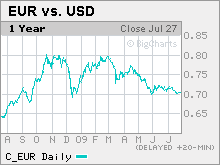Dollar climbs as investors seek safety
The greenback gains traction, reaching a two-week high against the euro, as investors shy away from riskier investments.
NEW YORK (Reuters) -- The U.S. dollar advanced to a two-week high against the euro Wednesday, as steep losses in Shanghai's stock market and an unexpectedly weak U.S. durable goods report bolstered the greenback's appeal as a safe haven.
Falls in U.S. equities and a 5.0% slide in China's benchmark Shanghai Composite Index sapped investors' appetite for risk. That helped the U.S. dollar index recover from its lowest level of 2009, pushed the euro to a two-week low near $1.40, and boosted the yen versus the commodity currencies such as the Australian and New Zealand dollars.
Both the yen and dollar benefit in times of extreme risk aversion in the market.
"The dollar is moving with the ebb and flow of risk appetite," said Samarjit Shankar, director of global strategy at Bank of New York Mellon (BK, Fortune 500) in Boston.
"Today, risk is off and the dollar is gaining. It started with the collapse in Shanghai stocks and people are wondering whether the foray into risk assets may have been overdone."
In late afternoon trading, the euro dropped 1.0% against the dollar to $1.4037 after hitting $1.4008, its lowest since July 15.
On Tuesday, the euro zone currency rose as high as $1.4303, its highest since early June, according to Reuters data.
The ICE Futures' dollar index, which measures its performance against a basket of six other major currencies, rose 0.8% to 79.507, rebounding from a 2009 low of 78.315 set the previous day.
Adding to dollar strength was a government report showing new orders for long-lasting U.S. goods fell more sharply than expected in June, which further weighed on risk sentiment.
The U.S. Commerce Department said durable goods orders fell 2.5% in June, the largest drop since January and worse than market expectations for a 0.6% decline.
"This has translated into a weak equity market and a pullback from dollar shorts in the currency market with the risk-off scenario playing out," said Andrew Busch, global FX strategist at BMO Capital Markets in Chicago.
The euro was last down 0.3% against the yen at ¥133.09, while the dollar rose 0.6% to ¥95.14. The Australian dollar, meanwhile, fell 0.5% versus the yen to ¥77.67.
The latest Federal Reserve Beige Book survey, saying the U.S. recession has moderated, had little impact and failed to appease the market's already nervous mood.
Sentiment on the dollar was not dented despite a disappointing $39-billion five-year U.S. Treasury auction on Wednesday. The bid-to-cover ratio, which measures demand for the five-year notes, was just 1.92, the lowest in almost a year. That followed a poor auction on Tuesday.
Indirect bidders, a gauge of foreign interest, accounted for only 37% of bids when the previous average was more than 50%. On Tuesday, indirect bidders were just 33%.
Growing optimism about the global economic outlook had pressured the U.S. currency in recent weeks and fueled a rally in stocks, commodities and higher-yielding currencies.
But some disappointing U.S. earnings this week and a drop in U.S. consumer confidence have prompted investors to once again seek shelter in the dollar.
The Aussie dollar fell 1.2% against its U.S. counterpart to US$0.8166, while the New Zealand dollar declined 0.4% to US$0.6550.
The Canadian dollar, which is particularly sensitive to oil prices, also fell, with the U.S. dollar up 0.8% at C$1.0889. ![]()


